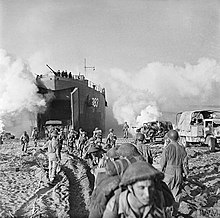This article has multiple issues. Please help improve it or discuss these issues on the talk page. (Learn how and when to remove these messages)
|
| Operation Avalanche | |||||||
|---|---|---|---|---|---|---|---|
| Part of the Invasion of Italy | |||||||
 British infantry landing on Salerno, September 1943. | |||||||
| |||||||
| Belligerents | |||||||
|
|
| ||||||
| Commanders and leaders | |||||||
|
|
| ||||||
| Strength | |||||||
| 170,000 servicemen[1] | 35,000 Germans[2] | ||||||
| Casualties and losses | |||||||
|
2,149 killed 7,365 wounded 4,099 missing |
840 killed 2,002 wounded 603 missing | ||||||
Operation Avalanche was the codename for the Allied landings near the port of Salerno, executed on 9 September 1943, part of the Allied invasion of Italy during World War II. The Italians withdrew from the war the day before the invasion, but the Allies landed in an area defended by German troops. Planned under the name Top Hat, it was supported by the deception plan Operation Boardman.
The landings were carried out by the U.S. Fifth Army, under Lieutenant General Mark W. Clark. It comprised the U.S. VI Corps, the British X Corps, and the U.S. 82nd Airborne Division, a total of about nine divisions. Its primary objectives were to seize the port of Naples to ensure resupply, and to cut across to the east coast, trapping the Axis troops further south.
In order to draw troops away from the landing ground, Operation Baytown was mounted. This was a landing by the British Eighth Army, under General Sir Bernard Montgomery, in Calabria in the 'toe' of Italy, on 3 September. Simultaneous sea landings were made by the British 1st Airborne Division at the port of Taranto (Operation Slapstick). The Salerno landings were carried out without previous naval or aerial bombardment in order to achieve surprise. Surprise was not achieved.
The Germans had established artillery and machine-gun posts and scattered tanks through the landing zones which made progress difficult, but the beach areas were captured. Around 07:00 a concerted counterattack was made by the 16th Panzer Division. It caused heavy casualties but was beaten off. Both the British and the Americans made slow progress, and still had a 10 miles (16 km) gap between them at the end of day one. They linked up by the end of day two and occupied 35–45 miles (56–72 km) of coastline to a depth of 6–7 miles (9.7–11.3 km).
Over 12–14 September the Germans organized a concerted counterattack by six divisions of motorized troops, hoping to throw the Salerno beachhead into the sea before it could link with the British Eighth Army. Heavy casualties were inflicted, as the Allied troops were too thinly spread to be able to resist concentrated attacks.[4] The outermost troops were therefore withdrawn in order to reduce the perimeter. The new perimeter was held with the assistance of naval and aerial support, although the German attacks reached almost to the beaches in places.
- ^ Morris 1993, p. 215
- ^ Martin Blumenson, United States Army in World War 2, Mediterranean Theater of Operations, Salerno to Cassino (1969). Washington DC, Government Printing Office, p. 67.
- ^ a b c Konstam 2007, p. 157
- ^ Cite error: The named reference
whnwas invoked but never defined (see the help page).